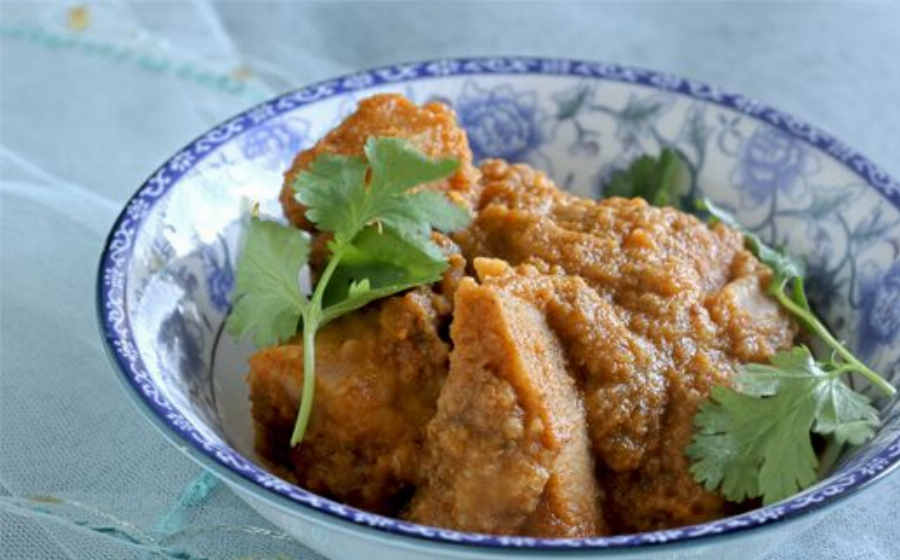Taro korma is an Indian vegetable curry. The spicy gravy contains fried onion paste and yogurt and is flavored with ginger-garlic paste as well as several Indian spices. Taro pieces are fried till crispy, and then finish cooking in the curry paste. Taro is a very starchy ingredient that makes the gravy a lot thicker and denser when added.
Kormas can be either vegetarian or ”non-veg” with any assortment of vegetables, fried cheese such as paneer, or meat such as goat korma. I came up with this dish for a very simple reason: there was a basket full of taro waiting to be cooked! Taro root usually doesn’t keep for more than a week, and it will turn sour when it’s mixed and stored in the freezer. Buy it close to when you’re ready to cook, and enjoy it. It’s definitely worth the effort.
1. Info for Taro Root Korma Recipe
- Cook Time: 40 mins
- Total Time: 60 mins
- Servings: 6
- Calories: 185 kcal
2. Ingredients for Taro Root Korma Recipe
- 6 taro roots
- ¼ cup canola oil (or any neutral oil)
- 2 teaspoons ginger garlic paste
- ¼ teaspoon turmeric powder
- ½ teaspoon red chili powder
- ¼ teaspoon black pepper
- 1 teaspoon paprika
- 1-½ teaspoons ground cumin, freshly ground
- ¼ teaspoon ground cardamom, freshly ground
- 1-½ cups fried yellow onions, chopped
- 1 teaspoon salt
- ½ cup coconut milk
- 1 cup plain yogurt
- ¼ teaspoon fenugreek seeds
- 4 fresh curry leaves, torn in half
- 4 dried red chiles
3. Directions:
- Peel and quarter the taro roots.
- Taro root is toxic when it’s raw, so don’t let it stand too long before frying it. In a deep non-stick pan, heat about 3 tablespoons oil. Add the taro pieces. Reduce the heat to medium-high. Slightly cover the pan with a sheet of aluminum foil. Cook for about 3 minutes. Toss frequently, as soon as one side is nicely fried, crisp and slightly golden brown. Gently lift the taro roots using a silicone spatula without applying any pressure so they remain crispy and don’t get smashed. Sprinkle the crisp taro pieces with a little salt. Add more oil if needed. Cook for another 3 minutes. Quickly transfer the fried taro to a platter, leaving as much oil as possible in the pan. At this point the taro isn’t cooked completely; it will finish cooking in the creamy gravy.
- In a blender or a mini-blender if you have one, mix the onions and about 2-3 tablespoons of water so the onions blend more easily. Set aside.
- In the same deep non-stick pan, add more oil if necessary. Add the ginger garlic paste, red chili powder and spices (cardamom, cumin, paprika and turmeric). As soon as ithe mixture is golden and fragrant, add the fried onion paste, the yogurt and about 2 cups water. Cook for about 5 minutes. Add more water if necessary. Add the fried taro pieces. Bring to a full boil then lower the heat to medium-low. Cover with a dome-shaped lid to enable the steam to fall back in the saucepan. Cook for about 15-20 minutes, stirring often. Season with salt and pepper. Finish with coconut milk. Bring to a full boil one more time, and cover with the lid.
- You could add water to the desired thickness (I didn’t). Check seasoning. Transfer to a serving bowl.
- This step is called Baghar: When you’re ready to serve, heat 1 tablespoon of canola oil in a small saucepan, add the fenugreek seeds and curry leaves and cook until fragrant. Add the whole dried red chiles. Cook in the hot oil; the chiles will darken and the oil will start splattering. Remove from the heat and immediately transfer to the taro korma. Cover the korma dish with a lid (I used a plate to preserve the nice fragrance).
- Serve immediately. Garnish with cilantro.
- I served this with some basmati rice.
- Bon appétit!

